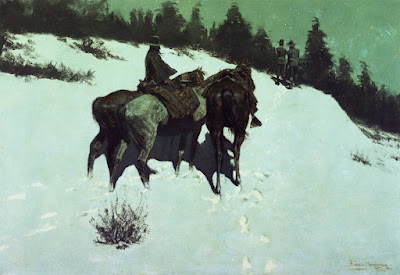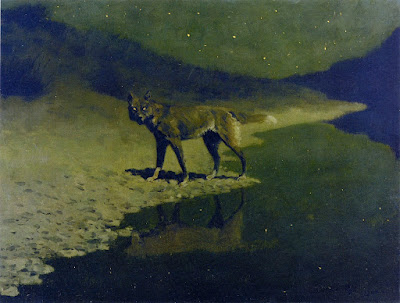24. American (& Canadian) Impressionism
What was it about? What were the goals?
This is (almost) as simple as it sounds. A large number of American and Canadian artists imitated the style of the Impressionists in France. In fact, many of them went to France to study and exhibit their work––it was like a rite of passage at the time. Impressionism was a global movement. You can find them everywhere. In the US, they mostly focused on landscapes and domestic scenes of the upper class.
So where does it get complicated? Well, a great many American artists wouldn't have called themselves Impressionists, just as Edouard Manet never joined with them, even though he admired them (remember, the word impressionist was first used as a derogatory term). But, a great many of these artists were influenced by the Impressionists to such an extent––the use of new colors and materials, the bold, flamboyant brush strokes, the pull towards modernity and realism, the general rebelliousness and pull toward creative independence. These artists borrowed a great deal from the Impressionists just as they did from the academic art produced at the time. Their work became a synthesis of these competing approaches to painting. Most art history books don't refer to them as Impressionists, but, if you look to the early work of the French Impressionists, there's a clear connection, just as the French Impressionists show a clear connection to the Realists and Barbizon schools that came before them. In fact, some American Realist painters (noted below) had a style of painting even more impressionistic than the Impressionists. I will try to make this case in this and other lessons.
A bit of historical context:
French Impressionism began in the 1860's, and several major art exhibits came to the US by the 1880's, in NYC and Boston. Of course, many American artists would have already heard of this movement sooner from the news and from traveling to Paris, which was an artist's Mecca throughout the 19th century. Still, it was difficult to popularize the movement in the US, especially due to what was considered vulgar nudity.
Mary Cassatt played a large role in bringing Impressionism to the US. She was the only American artist to exhibit her work in France with the original Impressionist artists: Monet, Renoir, and Degas. She used her connections to wealthy friends and patrons to encourage the sale and promotion of Impressionist art in America.
Soon, several art colonies popped up around the US where painters could afford to live and had an abundant variety of subjects to paint. Such colonies were in Gloucester and Provincetown in Massachusetts, Cos Cobb and Old Lyme in Connecticut, New Hope Pennsylvania, Carmel & Laguna in California, Brown County in Indiana, and Shinnecock in New York.
Text books will tell you American Impressionism faced its downfall in the 1913 Armory Show of modern art in NYC. And, it's true it motivated American artists and institutions to modernize. But, it's not true that American Impressionism ended. It simply stopped getting the focus and praise it deserves. Impressionism is still the default way to teach painting in many of America's schools, and is still commonly found in galleries everywhere.
Another thing to note, the sheer scale of artists listed here is unprecedented in previous art movements. This was the beginning of a new modern renaissance that continues to this day. This was the result of industrialization and modernization. It created a booming population, beyond anything the world had ever seen before. It created a large middle class and upper class eager to decorate their homes with art. And, it saw the founding of many new schools, giving more and more opportunities to learn how to make art.
The underlying philosophy of the period:
How was it represented in the other arts – music, architecture, and literature?
Was it great?
Some leading figures:
Winslow Homer (American, 1836-1910) Considered more of a realist, his work varies, some of it more closely aligned with the Hudson River School. Winslow's art defies labelling.
John Enneking (American, 1841-1916)
Mary Cassatt (American, 1844-1926)
Frank Duveneck (American, 1848-1919)
Hugh Bolton Jones (American, 1848-1927)
Lilla Cabot Perry (American, 1848-1933)
William Merritt Chase (American, 1849-1916)
George Hitchcock (American, 1850-1913)
Richard Gruelle (American, 1851-1914)
Theodore Robinson (American, 1852-1896)
Edward Simmons (American, 1852-1931)
John Henry Twachtman (American, 1853-1902)
William Brymner (Canadian, 1855-1925)
Cecilia Beaux (American, 1855-1942)
John White Alexander (American, 1856-1915)
John Singer Sargent (American, 1856-1925)
Colin Campbell Cooper (American, 1856-1937)
Edward Potthast (American, 1857-1927)
Francis Coates Jones (American, 1857-1932)
Joseph DeCamp (American, 1858-1923)
Willard Metcalf (American, 1858-1925)
Childe Hassam (American, 1859-1935)
Henry Ossawa Tanner (American, 1859-1937)
Laura Muntz Lyall (American, 1860-1930)
Dennis Miler Bunker (American, 1861-1890)
Roswell Stone Hill (American, 1861-1907)
Frederick Remington (American, 1861-1909)
Edmund Tarbell (American, 1862-1938)
Frank Benson (American, 1862-1951)
Paul Cornoyer (American, 1864-1923)
Robert Henri (American, 1865-1925)
Lee Lufkin Kaula (American, 1865-1957)
Maurice Cullen (Canadian, 1866-1934)
Guy Rose (American, 1867-1925)
George Luks (American, 1867-1933) Part of the Ashcan Realist School.
Maren Froelich (American, 1868-1921)
Frank Dudley (American, 1868-1957)
William Paxton (American, 1869-1941)
Thomas Barnett (American, 1870-1929)
William Glackens (American, 1870-1938) Part of the Ashcan Realist School.
John Sloan (American, 1871-1951) Part of the Ashcan Realist School.
Charles Hawthorne (American, 1872-1930) Founded the Cape Cod School of art, also called the Hawthorne School of Art.
James Edward Harvey MacDonald (Canadian, 1873-1932)
Frederick Frieseke (American, 1874-1939)
William Howe Foote (American, 1874-1965)
John F. Carlson (Swedish-American, 1875-1947)
Ellen Emmet Rand (American, 1876-1941)
Alson Clark (American, 1876-1949)
William Herbert "Buck" Dunton (American, 1878-1936) Helped found the Taos Society of Artists.
McNicoll, Helen Galloway (Canadian, 1879-1915)
Daniel Garber (American, 1880-1958)
Clarence Gagnon (French Canadian, 1881-1942)
Edgar Alwin Payne (American, 1883-1947)
William Victor Higgins (American, 1884-1949)
Mary Agnes Yerkes (American, 1886-1989)
John Frost (American, 1890-1937)
Carmichael, Frank (Canadian, 1890-1945)
John Folinsbee (American, 1892-1972)
Emile Gruppe (American, 1896-1978)
Richard Schmidt (American, 1934-2021)
Nancy Guzik (American)
Susan Lyon (American)
Rose Frantzen (American)
Some of the greatest artworks of the time:




.jpg)































,%20Madame%20Michel.jpg)




















Comments
Post a Comment